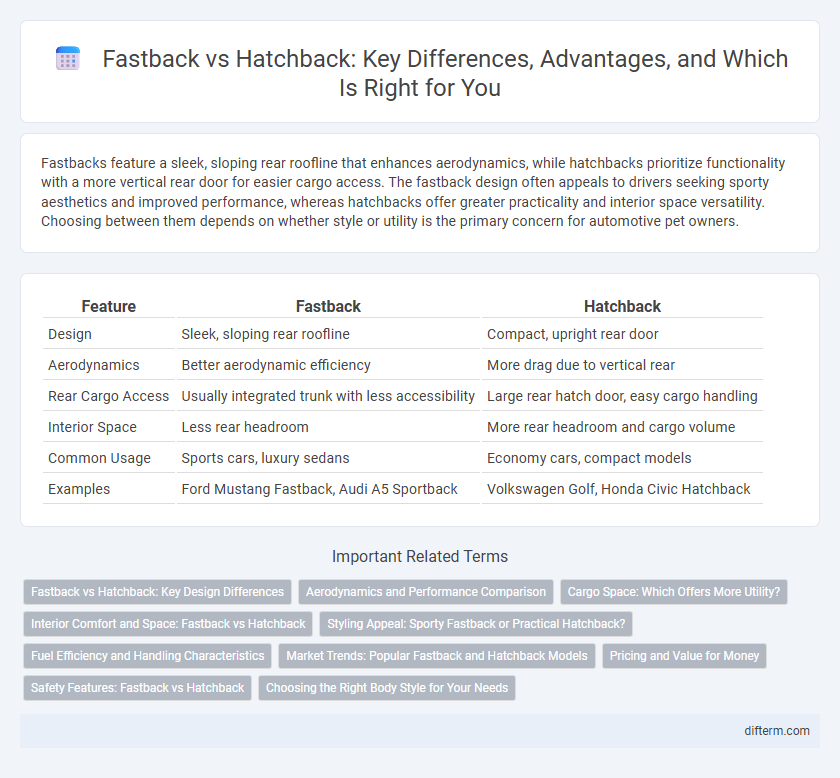Fastbacks feature a sleek, sloping rear roofline that enhances aerodynamics, while hatchbacks prioritize functionality with a more vertical rear door for easier cargo access. The fastback design often appeals to drivers seeking sporty aesthetics and improved performance, whereas hatchbacks offer greater practicality and interior space versatility. Choosing between them depends on whether style or utility is the primary concern for automotive pet owners.
Table of Comparison
| Feature | Fastback | Hatchback |
|---|---|---|
| Design | Sleek, sloping rear roofline | Compact, upright rear door |
| Aerodynamics | Better aerodynamic efficiency | More drag due to vertical rear |
| Rear Cargo Access | Usually integrated trunk with less accessibility | Large rear hatch door, easy cargo handling |
| Interior Space | Less rear headroom | More rear headroom and cargo volume |
| Common Usage | Sports cars, luxury sedans | Economy cars, compact models |
| Examples | Ford Mustang Fastback, Audi A5 Sportback | Volkswagen Golf, Honda Civic Hatchback |
Fastback vs Hatchback: Key Design Differences
Fastbacks feature a sloping rear roofline that seamlessly extends to the trunk, creating a sleek, aerodynamic silhouette, while hatchbacks have a shorter rear overhang with a more vertical rear door for easy cargo access. Fastbacks often emphasize sporty aesthetics and improved airflow, contributing to enhanced performance and fuel efficiency compared to hatchbacks. Hatchbacks prioritize practicality and versatility, offering a larger, more accessible cargo area suitable for daily use and urban driving.
Aerodynamics and Performance Comparison
Fastbacks typically offer better aerodynamics due to their sleek, sloping roofline, which reduces drag and enhances high-speed stability compared to hatchbacks. Hatchbacks, while more practical with their vertical rear end, usually create more air turbulence, leading to slightly lower fuel efficiency and performance metrics. Performance-wise, fastbacks often capitalize on aerodynamic efficiency for improved acceleration and handling, whereas hatchbacks prioritize versatility and cargo space over top-end speed.
Cargo Space: Which Offers More Utility?
Fastbacks generally offer a more aerodynamic design with a sloping rear roofline, which can slightly reduce cargo space compared to hatchbacks, known for their vertical liftgate and boxier rear end that maximize storage capacity. Hatchbacks provide greater utility by allowing larger and more flexible cargo configurations, typically featuring fold-flat rear seats that enhance usable space. In practical terms, hatchbacks usually offer superior cargo volume and easier access, making them the preferred choice for drivers prioritizing utility and storage versatility.
Interior Comfort and Space: Fastback vs Hatchback
Fastback models often provide a more spacious and luxurious interior due to their elongated roofline, enhancing rear headroom and legroom for passengers. Hatchbacks typically maximize cargo versatility with a rear door that opens upwards, offering easier access to the storage area and more flexible seating configurations. Both body styles prioritize driver ergonomics, but fastbacks lean towards a premium feel, while hatchbacks emphasize practicality and efficient use of interior space.
Styling Appeal: Sporty Fastback or Practical Hatchback?
Fastbacks feature a sleek, aerodynamic silhouette with a sloping rear roofline that enhances their sporty, dynamic appeal, making them popular for drivers seeking a performance-inspired look. Hatchbacks prioritize practicality with a boxier rear and a liftgate that offers easy access to a spacious cargo area, appealing to those who value functionality and versatility. Both styles serve distinct preferences, with fastbacks emphasizing style and speed, while hatchbacks maximize usability and everyday convenience.
Fuel Efficiency and Handling Characteristics
Fastbacks typically offer better aerodynamics due to their sloping roofline, which can enhance fuel efficiency compared to hatchbacks with a more upright rear design. Hatchbacks often provide superior handling characteristics because of their compact size and lower center of gravity, contributing to improved maneuverability and cornering stability. Fuel efficiency in both body styles depends heavily on engine specifications, but fastbacks generally maintain an edge in highway mileage.
Market Trends: Popular Fastback and Hatchback Models
The market shows rising consumer interest in fastback models such as the Tesla Model 3 and BMW 4 Series Gran Coupe, driven by their aerodynamic design and sporty aesthetics. Hatchbacks like the Volkswagen Golf and Honda Civic continue to dominate with practicality and fuel efficiency, appealing to urban drivers. Trends indicate a shift toward electric and hybrid variants within both categories as environmental regulations tighten and sustainable mobility gains traction.
Pricing and Value for Money
Fastbacks typically command higher prices due to their sleek design and often premium features, positioning them as a more stylish yet costly option. Hatchbacks offer greater value for money with lower starting prices and practical interior space, appealing to budget-conscious buyers seeking versatility. When comparing costs, hatchbacks generally provide more affordable maintenance and better fuel efficiency, enhancing overall ownership savings.
Safety Features: Fastback vs Hatchback
Fastbacks often feature advanced aerodynamics that contribute to stability and enhanced safety during high-speed driving, while hatchbacks typically offer greater rear visibility and easier access to cargo areas, aiding situational awareness. Both body styles incorporate modern safety technologies such as multiple airbags, electronic stability control, and collision avoidance systems, ensuring comprehensive occupant protection. The choice between fastback and hatchback influences safety primarily through design impacts on crash dynamics and driver visibility rather than fundamental safety system differences.
Choosing the Right Body Style for Your Needs
Fastbacks offer a sleek, aerodynamic design with a sloping rear roofline, ideal for buyers prioritizing style and sporty performance in their vehicles. Hatchbacks provide enhanced practicality through a rear door that opens upwards, maximizing cargo space and ease of access, which suits urban drivers and families. Evaluating your lifestyle needs, such as cargo capacity and aesthetic preference, helps determine whether the fastback's dynamic look or the hatchback's versatile functionality is the better choice.
fastback vs hatchback Infographic

 difterm.com
difterm.com